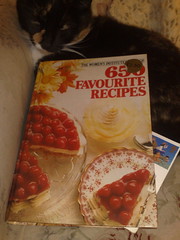
(My lovely feline assistant/prop, Rotunda the Munificent, is a fan of the blog.)
The Women's Institute is a quintessentially British institution. In American terms, it is a Ladies' Auxiliary to, well, Britain. The movie Calendar Girls is a rather good introduction, if you have access to it. As an extra special treat, one gets to see Helen Mirren's baps. (Yes, that means what you think it does.)
Gastronomically renowned for its cakes, biscuits, jams and marmalades, which are displayed in annual summer fêtes inevitably involving contests and rain, this 1980 edition of the WI's 650 Favourite Recipes does provide some spectacular fail in the very best Lileks tradition:
The "Brackenhurst Iced Prawn Curry" sounds utterly foul: a chilled mayonnaise-prawn-curry-powder concoction over rice, all chilled, no actual south Asian affiliation in the slightest.
"Fish Flan" sounds as grim as it is likely dentally unchallenging, and the "Canapés Diane" instructs one to remove fat from streaky (i.e., American-style) bacon. It doesn't specify how one is supposed to do that, nor what it expects to be left of the streaky bacon afterwards.
The Prizewinners (sic) category includes the likely "Low Calorie Tomato and Lettuce Soup", which carries the ever-useful note, "over-ripe tomatoes and mis-shapen lettuce leaves may be used". The recipe itself is, essentially: boil lettuce, tomatoes and onions with stock cubes and marjoram. Serve. Despair. (I may have made the last instruction up.)
I refuse to even look at the Pasta & Rice section, because I grew up mainly in New York with two years in Rome and a year in Beijing, and I would probably cry.
That said, there is much good contained amongst the stomach-churningly dire, and I would use this book as a starting point for any traditional recipe I wished to adulterate in the very best Modern British fashion.
Now, as one might expect given that the British Empire was built on beatings, buggery and organ meats, the Meats section is resplendent with offerings of offal. There's a Gilbert and Sullivan joke in here somewhere, I'm certain. As far as the offerings go, perhaps Brains au Beurre? Fried Tripe? Baked Stuffed Hearts? That's only pages 96-97, of course. Freakout food apart, if I were wondering how to prepare sweetbreads, or any other organ meats I would turn to the WI in the first instance.
So, the third pillar of Empire dismissed, I shall provide a recipe speaking to the second: Faggots. No epithet they: rather, a sort of offal meatball to be eaten with gravy. You may well have seen the Internet picture of "Mr Brain's 4 Pork Faggots in a rich Westcountry Sauce" floating around in joke emails. One can certainly procure a box of faggots (11% pork!) in my local supermarket. (Really, America, you can stop laughing now.)
Instructions for WI faggots, which should serve four, appear on page 97 as follows:
Faggots
450g/1lb pig's fry (which a careful Google search tells me are sweetbreads, heart, liver and lungs)
3 small onions chopped
75g/3oz fresh breadcrumbs
1/2 teaspoon chopped fresh sage
1/2 teaspoon chopped fresh thyme
salt
pepper
1 pig's caul or veil, soaked in warm water (a caul is the thin, fatty lining of a pig's stomach, while a veil appears to be the same thing).
Ah, a recipe with two offal terms even the Brit has to look up. Marvellous. And it does rather seem to be continuing the British aversion to seasoning, because a total of one teaspoon of fresh herbs seems awfully light for strongly flavoured meat like offal. I would use a good two teaspoons of each if fresh, one of each if dried.
Anyway, apparently one puts the meat and onions in a saucepan, covers with water and brings to a boil, simmering for 45 minutes. Drain the liquid, reserving a little to moisten the breadcrumbs. Mince the fry and onions, then mix in the moistened breadcrumbs, herbs, salt and pepper.
Drain the caul and cut into 2.5 or 5cm/1 or 2 inch squares. Divide the mixture between the squares and shape into balls. Pack the balls closely into a greased roasting tin. Bake in a preheated moderately hot oven (190°C/375°F/Gas Mark 5) for 45 minutes or until well browned. Serve with a good gravy and creamed potatoes.
I'm sure it's wonderfully flavourless like much British cooking is to modern palates. It's because of wartime rationing, I should imagine, that we have kept dishes like this in our national consciousness. That said, the key to modern palatability is almost certainly to use half and half ground pork and half and half liver. The caul or veil one can leave out thanks to the exciting modern invention of Teflon and tinfoil (aluminum foil for those of you in the Colonies, and yes, look how I spelt aluminium there!). As I said, I would boost the herbs too, and probably replace the breadcrumbs with oats for texture. I might even increase the levels of oats depending on how tender my faggots turned out. And you can bet your Aunt Nelly (or your nelly uncle) that I'd make proper gravy and skin-on mashed potatoes, rather than "creamed". Oh, yes, and also something green like curly kale or spring greens or even some tiny brussels sprouts. Ah, and almost certainly a good beer — brown stuff you can't see through, none of the yellow rubbish with bubbles.
Next time, we move to cake. Or death. Wait, cake!
Thanks, John!
ReplyDeleteYou're very welcome indeed! I rather enjoyed it. :)
ReplyDeleteI have always enjoyed this blog (Hi, Wendy), and I was a bit surprised to see this post. But I enjoyed it. Very droll!
ReplyDeleteThanks for making me want to vomit! Awesome!!!! :-)
ReplyDeleteI have always wanted to visit the UK. Apparently I will need to bring my own food. *makes note to self*